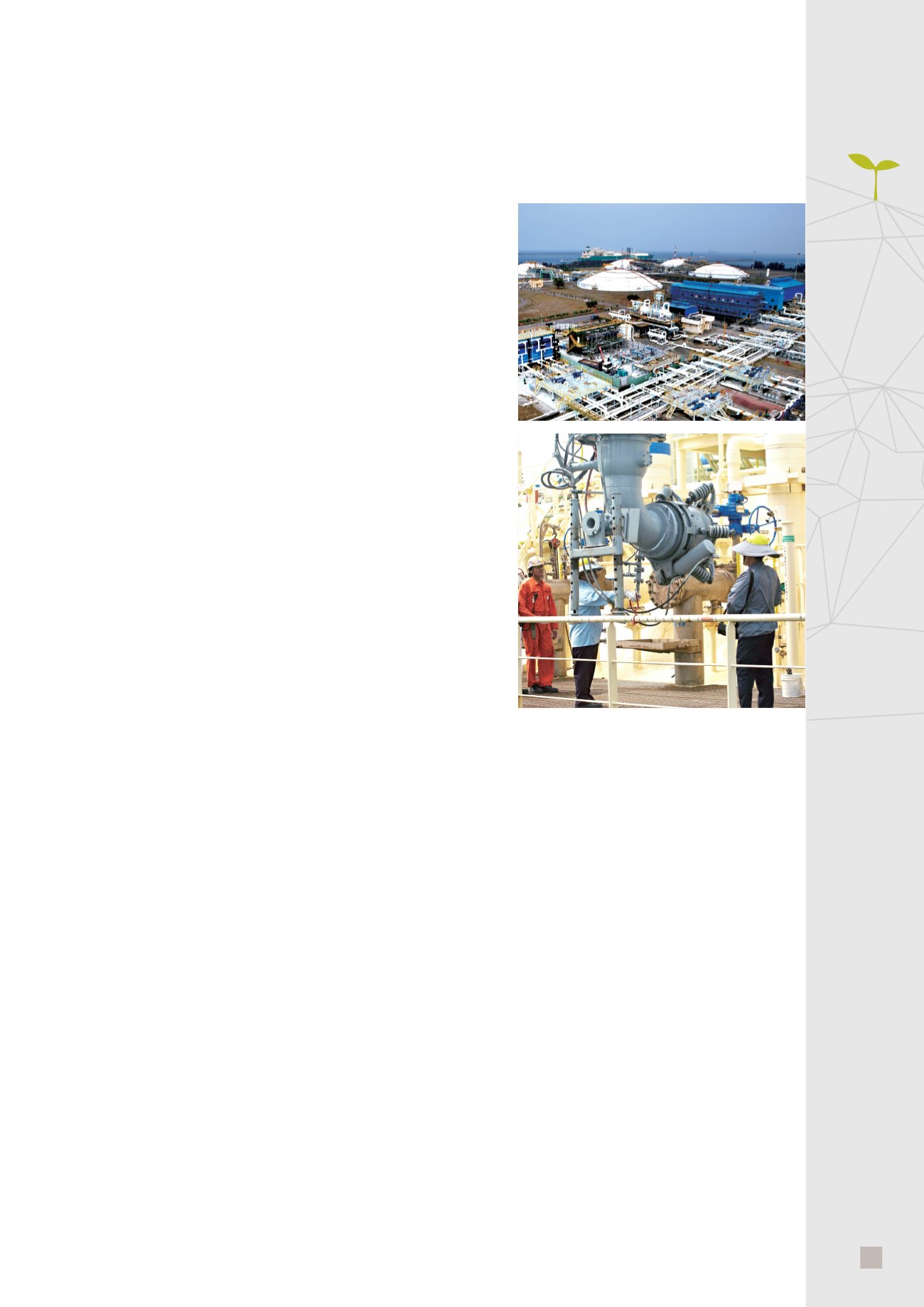
21
2013
CPC
Downstream Operations
Natural Gas
Taiwan's first liquefied natural gas (LNG) receiving terminal, in
Yongan District of Kaohsiung City, was completed in 1990 and
inaugurated a new era in the supply of clean energy on the island.
Based on the advantages of natural gas—high efficiency, lack
of pollution, safety and convenience—CPC has since moved in
line with the policy goal of energy diversification. Following rapid
growth of the domestic economy, the steady increase in energy
demand and the rise of environmental consciousness, CPC carried
out an expansion project at the Yongan receiving terminal; this was
completed in December 1996, boosting its annual handling capacity
to 4.5 million metric tons. To satisfy the future demand for natural
gas by independent power plants and towns in northern Taiwan,
CPC initiated a third-stage expansion project in July 1996; in addition
to expansion work in the terminal area, the company established
a precedent in Taiwan by laying a 36-inch diameter, 238km long-
distance undersea pipeline from Yongan to Tongxiao. Completion
of the pipeline in December 2002 expanded CPC's LNG handling
capacity to 7.44 million tons per year.
To meet the first-stage goal of supplying gas for use by Taipower's
Datan Power Station from 2008, and the second-stage goal
of completing storage tanks and related gasification and gas
supply facilities by the end of 2009 in order to supply the needs of
independent power plants, industrial customers, and city gas users
in central and northern Taiwan, CPC constructed an LNG receiving
terminal with a yearly capacity of 3 million tons in Taichung. This
project, costing an estimated NT$31.5 billion, was developed at West
Dock No. 13 in Taichung Harbor as well as inland; it includes three
160,000-kiloliter LNG tanks, gasification and gas supply facilities,
and a 135-kilometer, 36-inch sea/land long-distance transportation pipeline from Taichung Harbor through the
Tongxiao distribution station to the Datan measuring station, along with related facilities. The pipeline began
operating on July 13, 2009. At present, CPC is carrying out its Taichung LNG Receiving Terminal Phase II
Expansion Project: begun in 2012, it is expected to be completed in 2018; it includes three 160,000-kiloliter
above-ground tanks and a 21.8-kilometer 26-inch onshore gas pipeline from Taichung Harbor to the Wuxi
gas-isolation station. The project will increase the handling capacity of the Taichung terminal from 3mmtpa to
5mmtpa and, by providing more LNG storage capacity, enhance the stability and security of gas output during
the winter monsoon.
To make flexible use of its facilities so as to achieve stability of supply and demand in the gas market, CPC
has constructed a transmission and distribution system in western Taiwan that includes 1,757 kilometers
of trunk pipeline, 36 distribution stations and 1,471 kilometers of regional loop transmission networks
fed by eight supply centers. CPC's planning of gas pipelines is oriented toward the construction of loop
networks. It has already completed the laying of approximately 500 kilometers of trunk pipeline on land as
well as approximately 238 kilometers of undersea pipeline from Yongan to Tongxiao, together forming a
comprehensive loop pipeline network for central and southern Taiwan. In addition, after the 36-inch undersea
pipeline from Taichung Harbor through Tongxiao to Datan in Taoyuan County enters service it will form a loop
transmission network together with on-land pipelines in central and northern Taiwan, thus completing a "figure
8" gas transmission network.
CPC has worked to ensure a stable supply of gas by diversifying its sources and its own deployment. Apart
from the original long-term LNG sale and purchase agreements (SPAs) with Indonesia, Malaysia and Qatar,
from 2010 through 2012 CPC signed four new SPAs for the import of LNG from countries including Papua
New Guinea, Qatar, and Australia in order to meet demand for gas in Taiwan. To achieve the objective of
stabilizing supplies and diversifying sources, the company secures LNG mainly from Indonesia, Malaysia,
and Qatar through long-term agreements, with the remainder being supplied through mid-term and short-term
master agreements with the Republic of Trinidad and Tobago, Egypt, and Nigeria. In 2012 CPC sold a total of
16.01 billion cubic meters of natural gas - mainly for domestic power generation, co-generation, and industrial
users and household consumers.


